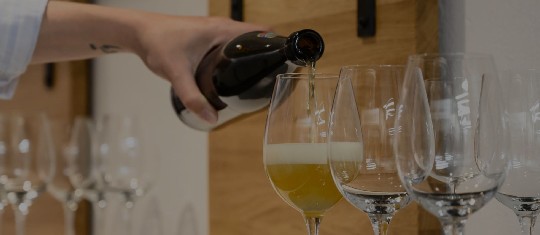What is hop oil? What flavor benefits does it bring to beer? Our expert for hop sensory analysis Christina Schönberger reveals tips and tricks for an intense hop aroma.
What is hop oil?
Hop oil is a small but important component of hops which, as an aroma-giving component, plays a major role in the taste and character of beer.
Hop cones consist of various components such as:
- minerals
- pectins
- sugars
- moisture
- cellulose
- proteins
- waxes
- lipids
- polyphenols
- hop oils
- alpha and beta acids.
Only about half of all these hop constituents have an effect on the beer, producing, for example, bitterness and hop aroma, supporting body, texture and cloudiness, or improving foam, flavor stability and shelf life. The influential 50 percent include alpha acid, beta acid, polyphenols, lipids, waxes and hop oil. Although the latter only accounts for up to four percent of total hops, it is the most important substance when it comes to hop aroma in beer. The hop oil content can vary from variety to variety, depending on the time of harvest and growing region.
Components of hop oil
Hop oil, in turn, consists of numerous components. The most prominent ones in terms of quantity are the so-called big four:
1. myrcene (53 %)
2. humulene (22 %)
3. caryophyllene (8 %)
4. farnesene (6 %)
and 9.2 percent other oils – and it is precisely these that are the real deal, because the compounds most influential for the taste of beer, such as linalool, caryophyllene, citronellol and beta-pinene, as well as aroma-active ketones, esters and thiols, are contained in this smallest proportion.
How is the oil content of hops determined?
Hop oil is measured by steam distilling 100 g hops for 3-4 hours. The hop oil is collected and measured in milliliter oil. Therefore, we describe hops as containing an oil content of, for example,
1 ml hop oil in 100 grams of hops = 1 ml/100 g = 1 % hop oil.
How is the hop charge calculated?
Citrusy, sweet fruit, berry fruit or floral notes: It is the hop oil that provides the aromas that characterize the new beer styles such as India Pale Ale, Dry-Hopped Lager or Juicy & Hazy IPA. They are transferred to the beer by means of so-called aroma addition, a term that covers late hop additions and cold hopping.
It is not uncommon to hear from the craft beer scene of exorbitant amounts of 8 lbs/US barrel (~3.1 kg/hl) being added to the beer.
The oil content of the hops, not the alpha acid content, is crucial for aroma additions. It is therefore essential to calculate the dosage according to the oil content of the hops, as the following example shows.
Hop oil = hop aroma
Below is a calculation on how we can figure out how much hops we need for an aroma addition:
Hops | Cascade | Beer | 10 hl |
Oil Content | 1 ml/100 g | - | - |
Late hopping Dosage | 2 ml/hl | 20 ml | 2000 g |
Dry-hopping Dosage | 4 ml/hl | 40 ml | 4000 g |
Table 1: Example for basic hop dosage for aroma
LATE HOPPING DOSAGE:
2 ml/hl dosage for 10 hl → 20 ml total oil dosage needed
20 ml ÷1 ml ×100 g= 2000 g hops
DRY-HOPPING DOSAGE:
4 ml/hl dosage for 10 hl → 40 ml total oil dosage needed
40 ml ÷1 ml ×100 g= 4000 g hops
The previous calculation would be a total hop dosage of 600 g/hl for late and dry-hop additions, which doesn’t come close to 3.1 kg/hl that we mentioned earlier. Below is a possible dosage at increased levels:
Dosage Point | Variety | α-Conent | Oil Content | Oil Dosage | Dosage Hops | Type of Dosage |
Begin of Boil | Magnum CO2 Extract | 40,0% | - | - | 4,8 | bitter |
Middle of Boil | Cascade | 7,0% | 1,0 | 3,00 | 300,0 | mainly bitter |
Whirlpool | T'n'T | 12,0% | 1,4 | 3,00 | 214,3 | mainly aroma |
Whirlpool | Yellow Sub | 9,0% | 1,5 | 3,00 | 200,0 | mainly aroma |
Whirlpool | Relax | 1,2% | 1,3 | 3,00 | 230,8 | mainly aroma |
Dry-hop | T'n'T |
| 1,4 | 7,00 | 500,0 | aroma |
Dry-hop | Yellow Sub |
| 1,5 | 7,00 | 466,7 | aroma |
Dry-hop | Relax |
| 1,3 | 7,00 | 538,5 | aroma |
Dry-hop | Cascade |
| 1,0 | 7,00 | 700,0 | aroma |
Table 2: Hop dosage (~3.1 kg/hl) for a Double IPA.
The intense hop dosages may make "hop heads" happy, but for brewing an ordinary lager or pale ale, as mentioned, they are excessive.
Have a question about hop oil and the interplay of aroma and flavor? Contact us at brewingsolutions@barthhaas.de.


